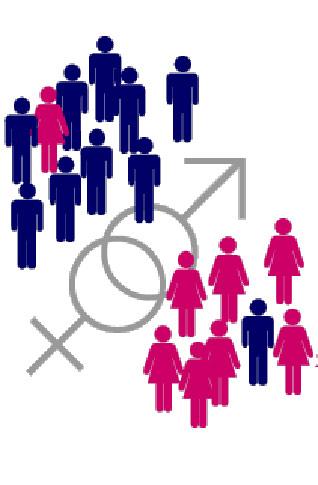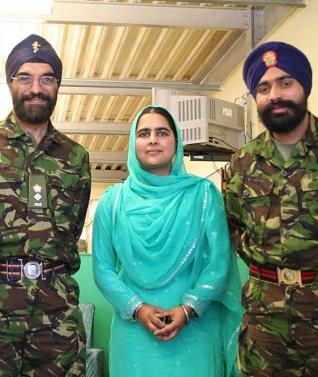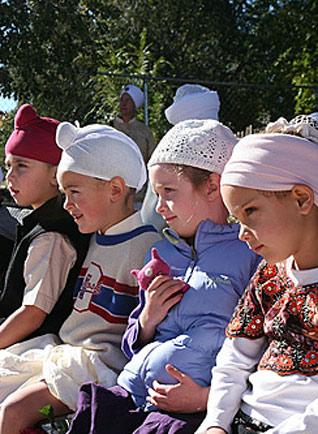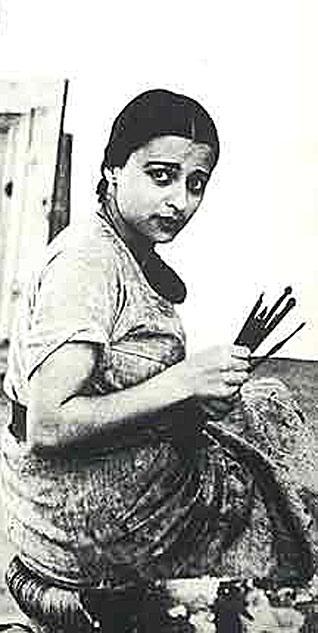
This page, second from bottom: detail from photograph by S. Gurumustuk Singh. Third photo from the bottom: U.K.'s Armed Forces Chaplain, Sardarni Mandeep Kaur (centre), flanked by two British soldiers.



Amrita
Shergill
Columnists
The Gender Trap
by I.J. SINGH
I suppose gender issues have been on my mind forever, though not quite in the same sense now as they used to be.
We all believe that Sikh teaching is so egalitarian and absolutely devoid of gender bias of any sort. Yet, we know our cultural practices and interpretations are so rife with gender issues, that an outsider may wonder if we are even part of this modern world.
For example, I have heard respected Sikh scholars opine that the initiation into the Khalsa tradition was not open to women. It is said that the name "Singh" might have been endowed upon men initiates, but a distinctive name, "Kaur", was not given to Sikh women at that time in 1699, because no women took Amrit and formally became Khalsa.
Forget for a moment that the assertion flies against all interpretations of the egalitarian teachings of gender equity by of the Gurus. To have preached one thing for over two centuries, and then capped the whole movement by a practice that stood the message on its head - how credible, sensible or possible would that be?
What is often most discouraging is the obvious disconnect between Sikh teaching and Sikh practice; in many ways, between our head and our heart.
But are we so unique in that? And, even if we are much like many others, what does it mean to us?
Let me stir the pot a little more vigorously by jumping in with both feet!
I notice that some churches require a certain number of men be present before the gathering can be recognized as a congregation; I know because I was once invited to stand in, even though I was just a visitor and clearly not a Christian, because the number of men was one short. And there were plenty of Christian women around, but they were ignored.
Certainly, in Orthodox Judaism, it takes ten men to form a minyan; nine men and a woman would not do. On the other hand, most Conservative and all Reform synagogues not only include women in this count, but also accept female rabbis.
Make no mistake, women are not unimportant to Judaism: the child of a Jewish mother is automatically accepted as a Jew, irrespective of the father's faith - it is a privilege not available to the child of a Jewish father and a non-Jewish mother.
In the Roman Catholic Church, women may become nuns but not priests; they may distribute the Host at Communion, but not consecrate it. Many other Christian denominations are not so self-limiting.
In Islam, I have never seen a woman imam.
Most Hindu sects do not have women serving as clergy; in fact, the Hindu code-giver, Manu, decreed that women were not to be allowed access to religious scriptures. Vestal virgins in Hindu temples were not uncommon at one time, nor are they absolutely extinct now. Yet, some Hindu sects have women who serve as leaders and clergy in temples.
Why is it that in so many of the major religions of the world, including Sikhism, the public role of women has often been so diminished, even while they clearly recognized their importance in the rearing of children of faith?
If a problem is found pretty much universally, and is associated with most of the major religions, perhaps we should look for an explanation, not so much in religious doctrines or even in the fragile egos of men, but in the universal constraints of human societies that transcend geographical and cultural boundaries, and end up compromising the most rigidly-held beliefs.
Most societies that label themselves "secular" are also not free of gender bias; for instance, women in the United States won the right to vote only in 1920, after a protracted struggle. And even today, in the 21st century, we are still debating whether a woman can be elected president.
(Keep in mind, dear reader, that I am exploring possible explanations, not finding justifications for our less-than-perfect lives.)
I offer you, first, the undeniable fact that, until very recently in human history, men and women led essentially segregated lives; the primary determinants for this were biological and economic.
Since the biologically more muscular men were the hunter-gatherers, and women were saddled with birthing children and nursing them, society essentially became male-dominated, and gender-centered.
Historically, across the cultural spectrum, except for a very few enclaves, upon marrying, a woman moved into the joint family structure of the husband. Perhaps it stemmed from the perceived need to preserve the family land holdings as undivided in primarily agricultural societies. But, it naturally led to the tacit assumption that the woman would adopt the religion and lifestyle of the husband and his family.
The remnants of such assumptions can be clearly seen even today, when upon marriage, the woman adopts the last name of the husband, or when in most church weddings, the father of the bride symbolically hands over his daughter to the groom. I know that exceptions to this are now increasingly common, but they are still few, and are of recent vintage.
Most communities saw that, for mothers, the primary concern had to be children. They also recognized that cultural and familial values would be transmitted largely through the mothers, not by their oft-absent fathers. Women, therefore, deserved more leeway.
Could women always be there at the beginning of the religious service? Would they have the time to spend learning the rites and rituals, or parsing the meaning of doctrine?
In 1699, how was it the first five Sikhs who responded to the call for a head were males? Why didn't women seem to heed the call of Guru Gobind Singh for a head? Perhaps they were busy with their squabbling children who were climbing all over them. Perhaps they never even heard the call - there were no public address systems and amplifiers then.
Also, history tells us that about 80,000 people attended the event staged by Guru Gobind Singh. These hordes had to be fed; it is possible that the langar kitchen might have claimed the attention and energy of the women.
Also, I remind you that the cultural values of the times assumed that women (and families) would automatically follow the path that their men chose.
Yet, we know that many women must have imbibed the values of the Khalsa very well and, at times, even better than the men had. When forty Sikhs deserted Guru Gobind Singh, they were shamed into returning by a woman, and she - Bhag Kaur - led them back to battle. To lead and to command these men, she must have been a proficient horsewoman and an expert with weapons of war. Only then would men have willingly, even admiringly, followed her into battle.
Could she have possibly learned these skills in a day or a week? Hardly! Would men have followed her if she was not competent enough to earn their respect? Likely not!
But women like Bhag Kaur, Rani Jind Kaur (Jindan) and countless others, were products of a certain time and culture in which their identity - even religious - was derived from that of their husbands and families. So, the civil or religious codes of society did not see any necessity to mention the role or position of women specifically and separately, except rarely.
My purpose in developing this argument, and very briefly providing a summary of what we find in other non-Sikh societies across time, culture and religion, is not to highlight our virtues or their shortcomings.
It is to suggest that our (Sikh) false starts and contradictions in gender issues are not unique to us. Undeniably though, we have effectively sidelined the women, and they are no longer central to our religious practices.
Times have changed; our awareness has grown. We need not flagellate ourselves for our past, but we do need to change our mind-sets and our institutions. And we will surely find that our Gurus left us a uniquely egalitarian message devoid of any gender bias, whether in our homes, businesses or religious institutions.
Reality now is different; the roles that women play in society are more equitable. Their skills are increasingly comparable, as are their rewards.
But religions, too, need to refresh their language and practice to reflect these changes. There is no dictum from God or Guru to prevent us from doing so. But we seem caught in a culture trap and a time warp.
I'll spare my readers a lecture on the lines from Gurbani that remind us of the equal place that women deserve in society.
So, when many religions adopted their codes, the intent might not have been to leave the women out, but the result inevitably was.
Now, the onus is on us.
Conversation about this article
1: Roma Rajpal (Santa Clara, U.S.A.), September 12, 2007, 11:59 PM.
Reading this wonderful article, I feel that, regardless of what any religion says about equality among the genders, thankfully, the gender gap is definitely closing with time. Education is the key. By pursuing higher studies, earning higher degrees, women get empowered, independent, and enjoy the freedom that men have enjoyed since the beginning of time. However, it is crucial that parents provide an environment for their children that is free of gender bias and prejudice, otherwise even the most educated girls will not develop the confidence, faith, or courage to live their lives according to their own will, and will end up taking a back seat in pursuing their own interests. An example from my own life is still inspiring to me. When I was in college back in the 80's, studying at the University of Connecticut, my father bought me a car and within a few weeks wanted to teach me how to change a flat tire and how to check the oil levels, etc. I showed some resistance, saying "This is something guys do" and "It's your kind of thing." I also added that he should take care of my car since I was still at their home. He refused: "It's your car, you have to learn to do the basic things, otherwise you are not driving." This happened over 25 years ago! How many fathers or mothers would do that today? I feel that episode empowered me. It becomes critical that we live our daily lives treating everyone around us fairly and equitably. Empower yourself. Empower everyone around yourself. Empower the world! This, I am sure, will make our Gurus proud.
2: Brijinder Kaur Khurana (New Delhi, India), September 13, 2007, 1:53 AM.
Thanks a lot, I.J. Singh ji, for bringing forward such an important issue. We are all given birth by females, our mothers, but the moment we step out of the house, we forget everything, we forget to respect other females, etc. I am writing this because I see it in society across the board. It is not my personal situation, fortunately, because I am enjoying every role at home: as a daughter, wife or mother. Everyone respects my feelings and life is full of joy to date, with the grace of God. But when I move around, I see the bad shape women are in: they have to beg even for petty things from their family. Even if they are working in outside jobs, they have to give double duty of managing the kids and household, as well as the job. And yet, it is thankless work. It's not only men, even women don't respect women because of their own, inner frustrations or their own past experiences. Your article will definitely open many eyes ...
3: Pritam Singh Grewal (Canada), September 13, 2007, 11:06 AM.
Well done I.J.Singh Ji: a thought-provoking and challenging call for practicing our Gurus' teachings. Better late than never. But a very serious problem of aborting female foetuses in Punjab seems to defy all religious and legal solutions. Isn't it our shameless hypocrisy to claim to be followers of "So keon manda akhiaye..." on the one hand, and aborting female fetuses, on the other? Who is going to change the social set-up now rife with evils such as dowry, etc?
4: R. Sandhu (Brampton, Canada), September 15, 2007, 2:05 AM.
I believe that equality was engrained upon the religion by none other than Guru Nanak himself. This was a first step in a society where, and at a time when, women did not play any manner of leading role, and all the clans where women did, had by then succumbed to the rules set up by entrenched clergy. Once the foundation was laid, there was nothing in the Sikh tradition to deny the women their position as equal members of the new egalitarian society: their role in the community was considered no less daunting than that of men. Therefore, the superimpostion of a new heirarchy is rather ridiculous. The intent was clear, so was/is the message ... it is time to heed it - not find silly reasonings to justify the contraventions to date or to sit in judgement over them.


